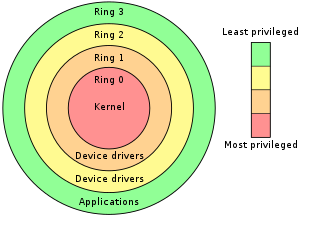In the security engineering subspecialty of computer science, a trusted system is one that is relied upon to a specified extent to enforce a specified security policy. This is equivalent to saying that a trusted system is one whose failure would break a security policy.

Security-Enhanced Linux (SELinux) is a Linux kernel security module that provides a mechanism for supporting access control security policies, including mandatory access controls (MAC).
In computer security, an access-control list (ACL) is a list of permissions associated with a system resource (object). An ACL specifies which users or system processes are granted access to objects, as well as what operations are allowed on given objects. Each entry in a typical ACL specifies a subject and an operation. For instance, if a file object has an ACL that contains (Alice: read,write; Bob: read), this would give Alice permission to read and write the file and only give Bob permission to read it.
In computer systems security, role-based access control (RBAC) or role-based security is an approach to restricting system access to authorized users. It is an approach to implement mandatory access control (MAC) or discretionary access control (DAC).
The Bell–LaPadula Model (BLP) is a state machine model used for enforcing access control in government and military applications. It was developed by David Elliott Bell and Leonard J. LaPadula, subsequent to strong guidance from Roger R. Schell, to formalize the U.S. Department of Defense (DoD) multilevel security (MLS) policy. The model is a formal state transition model of computer security policy that describes a set of access control rules which use security labels on objects and clearances for subjects. Security labels range from the most sensitive, down to the least sensitive.

This is a list of operating systems specifically focused on security. Operating systems for general-purpose usage may be secure without having a specific focus on security.
Rule-set-based access control (RSBAC) is an open source access control framework for current Linux kernels, which has been in stable production use since January 2000.
The Flux Advanced Security Kernel (FLASK) is an operating system security architecture that provides flexible support for security policies. It is a joint venture between the National Security Agency, the University of Utah, and the Secure Computing Corporation project designed to provide a framework for a more secure operating system. Development and implementation started with the Mach microkernel, and has since shifted its focus to the Linux operating system. FLASK is a core framework in security-focused operating systems such as NSA's Security-Enhanced Linux (SELinux), OpenSolaris FMAC and TrustedBSD. This means that SELinux can be thought of as an implementation of FLASK.
In computer security, mandatory access control (MAC) refers to a type of access control by which the operating system or database constrains the ability of a subject or initiator to access or generally perform some sort of operation on an object or target. In the case of operating systems, a subject is usually a process or thread; objects are constructs such as files, directories, TCP/UDP ports, shared memory segments, IO devices, etc. Subjects and objects each have a set of security attributes. Whenever a subject attempts to access an object, an authorization rule enforced by the operating system kernel examines these security attributes and decides whether the access can take place. Any operation by any subject on any object is tested against the set of authorization rules to determine if the operation is allowed. A database management system, in its access control mechanism, can also apply mandatory access control; in this case, the objects are tables, views, procedures, etc.
In computer security, discretionary access control (DAC) is a type of access control defined by the Trusted Computer System Evaluation Criteria "as a means of restricting access to objects based on the identity of subjects and/or groups to which they belong. The controls are discretionary in the sense that a subject with a certain access permission is capable of passing that permission on to any other subject ."
Multilevel security or multiple levels of security (MLS) is the application of a computer system to process information with incompatible classifications, permit access by users with different security clearances and needs-to-know, and prevent users from obtaining access to information for which they lack authorization. There are two contexts for the use of multilevel security. One is to refer to a system that is adequate to protect itself from subversion and has robust mechanisms to separate information domains, that is, trustworthy. Another context is to refer to an application of a computer that will require the computer to be strong enough to protect itself from subversion and possess adequate mechanisms to separate information domains, that is, a system we must trust. This distinction is important because systems that need to be trusted are not necessarily trustworthy.
Spring is a discontinued project in building an experimental microkernel-based object-oriented operating system (OS) developed at Sun Microsystems in the early 1990s. Using technology substantially similar to concepts developed in the Mach kernel, Spring concentrated on providing a richer programming environment supporting multiple inheritance and other features. Spring was also more cleanly separated from the operating systems it would host, divorcing it from its Unix roots and even allowing several OSes to be run at the same time. Development faded out in the mid-1990s, but several ideas and some code from the project was later re-used in the Java programming language libraries and the Solaris operating system.

In computer science, hierarchical protection domains, often called protection rings, are mechanisms to protect data and functionality from faults and malicious behavior.

AppArmor is a Linux kernel security module that allows the system administrator to restrict programs' capabilities with per-program profiles. Profiles can allow capabilities like network access, raw socket access, and the permission to read, write, or execute files on matching paths. AppArmor supplements the traditional Unix discretionary access control (DAC) model by providing mandatory access control (MAC). It has been partially included in the mainline Linux kernel since version 2.6.36 and its development has been supported by Canonical since 2009.
Linux Security Modules (LSM) is a framework allowing the Linux kernel to support without bias a variety of computer security models. LSM is licensed under the terms of the GNU General Public License and is a standard part of the Linux kernel since Linux 2.6. AppArmor, SELinux, Smack, and TOMOYO Linux are the currently approved security modules in the official kernel.
Multi categories security (MCS) is an access control method in Security-Enhanced Linux that uses categories attached to objects (files) and granted to subjects at the operating system level. The implementation in Fedora Core 5 is advisory because there is nothing stopping a process from increasing its access. The eventual aim is to make MCS a hierarchical mandatory access control system. Currently, MCS controls access to files and to ptrace or kill processes. It has not yet decided what level of control it should have over access to directories and other file system objects. It is still evolving.
The XTS-400 is a multilevel secure computer operating system. It is multiuser and multitasking that uses multilevel scheduling in processing data and information. It works in networked environments and supports Gigabit Ethernet and both IPv4 and IPv6.

Trusted Computer System Evaluation Criteria (TCSEC) is a United States Government Department of Defense (DoD) standard that sets basic requirements for assessing the effectiveness of computer security controls built into a computer system. The TCSEC was used to evaluate, classify, and select computer systems being considered for the processing, storage, and retrieval of sensitive or classified information.
In information security, computer science, and other fields, the principle of least privilege (PoLP), also known as the principle of minimal privilege or the principle of least authority, requires that in a particular abstraction layer of a computing environment, every module must be able to access only the information and resources that are necessary for its legitimate purpose.

In computer security, general access control includes identification, authorization, authentication, access approval, and audit. A more narrow definition of access control would cover only access approval, whereby the system makes a decision to grant or reject an access request from an already authenticated subject, based on what the subject is authorized to access. Authentication and access control are often combined into a single operation, so that access is approved based on successful authentication, or based on an anonymous access token. Authentication methods and tokens include passwords, biometric scans, physical keys, electronic keys and devices, hidden paths, social barriers, and monitoring by humans and automated systems.




